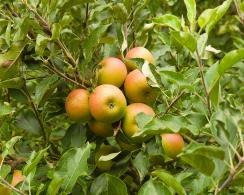Get Additional 5% Off 1st Order
Malus Domestica Rode Boskoop Red Dessert Apple Tree
Variant of the Popular Belle de Boskoop
1. Add items to basket
2. Go to the basket
3. Enter your postcode in Delivery Price Check
Plant shape: Double U-shape
Pot size: 20 Litres
Rootstock: m26 - Dwarfing
Plant ID: 13698 C 114
click to view this plant size >Malus Domestica Rode Boskoop (Boskoop Red Apple) is a deciduous fruit tree with tangy, mottled red apples in October and pink-white blossoms in April. It’s well-established across Europe, but relatively rare in the UK despite its outstanding qualities.
This Danish variant was introduced in the 1950s as a more coloured apple than its very popular Dutch parent plant Belle de Boskoop, which has been in cultivation since 1850. Rode Boskoop (often called Red Boskoop) retains many of its parent’s qualities, but its flesh has a slighter tarter flavour with a mild spicy aftertaste.
Its pollinator-magnet pink-white blossom arrives in April and matures to a profuse crop of large, red-flecked apples in mid to late autumn.
Lovers of crisp, tart, and slightly sour apples enjoy this high-quality variety.
Height and Spread of Malus Domestica Rode Boskoop
Boskoop Red Dessert apple trees reach a maximum height of seven metres with a broad spreading crown that’s just a shade smaller.
How Hardy is Malus Domestica Rode Boskoop
Fully UK hardy, Boskoop Red Dessert apple withstands winter’s frosts and snows if its roots are free-draining and it’s planted in fertile soil with full sun.
Whilst its blossom arrives in April and May, a late hard frost could damage the flowers. Ensure its not planted in a frost pocket.
How To Use Malus Domestica Rode Boskoop
Because Rode Boskoop is an upright grower, it suits small gardens and urban spaces.
Eat its crisp apples straight from the branch, store them for up to six months, freeze, juice, or dehydrate them. Windfalls are quickly eaten by thrushes and blackbirds.
For the largest apple crop, plant it with a pollinating partner that blossoms in April and May.
How To Care For Malus Domestica Rode Boskoop
Easy to grow Red Boskoop apple trees need a spot in full sun that’s free-draining and reasonably fertile. Apply a thick layer of organic mulch to its roots in spring and water it frequently for at least a year.
Apple trees require pruning in late winter to ensure a healthy crop of apples. Create an open crown with spaced-out branches by removing a third of the previous year's growth. Cut it just above an outward-facing bud and remove any crossed, weak, or damaged branches too.












